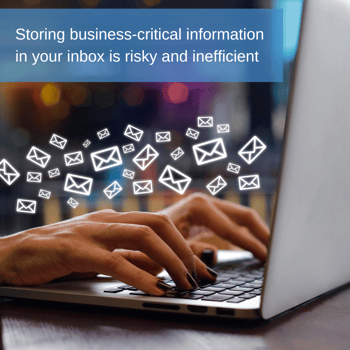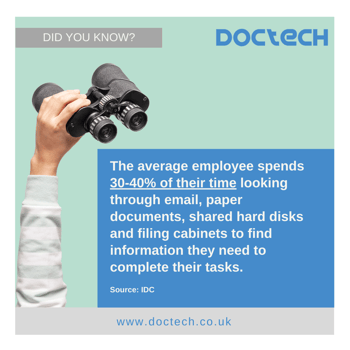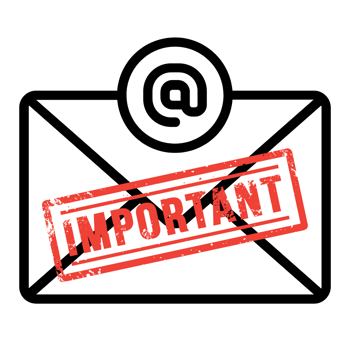In the modern workplace, the majority of documents generated across core business processes arrive and are distributed by email. As such, efficiently filing emails has never been more important in terms of saving time and money.
According to Zippia, approximately 347.3 billion emails are sent globally each day. That's a 4.2% increase from 2022 when 333.2 billion were sent each day. The number of emails sent per day will likely continue to increase, as projections say up to 376 billion emails will be sent per day in 2025 (a 12.8% increase).
Based on these numbers, it’s no wonder that effective email management and efficiently filing emails are now a key focus for businesses.
With increased pressure to cut costs yet remain compliant, business leaders are looking to minimise inefficiency and risk with their business processes. Identifying a better way of filing emails presents a great opportunity to tackle both issues.
For businesses, filing emails correctly is as crucial as the business information that sits within them. Think about all the communication, images and data stored in the average email inbox. Not to mention the attachments such as invoices, purchase orders, contracts, quotes, and documents where key decisions are being confirmed.
A misplaced email containing important information can be disastrous for a business. Is your company filing emails in a way which protects this intellectual property? Are you still printing emails and physically storing them, running the risk of loss or damage? Whatever the problem, read on to learn more about aspects of filing emails you should consider for your organisation.
A huge problem with important documents arriving via email and being sent out via email is the dreaded ‘shared mailbox’.
A shared mailbox is accessible by multiple team members and, unlike distribution lists, employees can send emails from the same email address. This is a blessing in many ways but also a curse in terms of risk.
It is absolutely imperative that a formal process is established when it comes to filing emails. These emails contain data which may form contractual agreements or provide evidence for financial transactions.
A shared mailbox is often used by sales, customer support and the accounts payable department but the information within them can be beneficial for any team.
Most departments have some sort of system in place for handling and filing emails but so often things can go wrong. We have put together these 10 top tips for processing and filing emails in shared mailboxes:
 An email is a document – sometimes it’s the actual email, sometimes it’s the email attachment and often it’s both. When looking at options for filing emails, this needs to be a consideration.
An email is a document – sometimes it’s the actual email, sometimes it’s the email attachment and often it’s both. When looking at options for filing emails, this needs to be a consideration.
Will you store the email and the attachments separately or altogether? Who will file the email and how will other users of the shared mailbox know?
Storing these documents in a dedicated document management system is the best advice on offer as they will be 100% secure.
Depending on the type of email received, they can be used to kick start workflows, generate tasks and create reminders. This all works towards optimising processes to work as efficiently and profitably as possible.
Having a formal process for filing emails makes total sense when you consider that almost all externally produced documents are received via email. Combine these with the documents created and sent between employees and it equates to some of the most valuable data within your business.
Many organisations receive high volumes of emails and struggle to organise them. Employees work from a shared inbox and have to manually track important documents for review. Often they spend too much time moving between different business applications causing delays to business processes.
Dedicated email folders can be monitored by our document management software, where an email is received, automatically stored and actioned without the reliance on staff intervention. This removes the need for drag and drop, scanning and renaming, and frees up employee time.
Document management software helps with email organisation by putting rules in place, ensuring all staff are filing emails and any other document in the same way. Financial Services provider Wettone Matthews did just this and benefitted from centralised business data and improved accessibility.
With a shared inbox receiving multiple emails from clients, knowing which member of staff has seen and actioned emails is difficult.
DocTech’s document management software provides a visual indicator on each email to show users what has been actioned and filed away. With emails and attachments no longer stuck in someone’s inbox, but stored in a centralised system, the next stage of the business process can begin. Whether that’s automated invoice processing, HR management or contract management.
Filing emails shouldn't be over looked but nor should it be a time-consuming process. With important information held across emails and attachments, organisations need to put effective systems in place to ensure no data is lost or held longer than it should be.
Speak to our team of experienced document management experts. We'll listen to your challenges and offer the best solutions available to make positive changes across your organisation.
With so many important business documents being sent electronically that are needed by the entire organisation, efficiently storing emails and providing access for colleagues has never been more vital.
Managing emails and the impact it has on productivity, has now become a big part of every office workers daily routine. A survey by McKinsey Global Institute, found that email is the second-most time-consuming activity for ...
A vehicle management system provides fleet management or fleet leasing companies everything they need to know on the status of their fleet. It collects, tracks and monitors data on vehicle's status, location, mileage, fuel ...